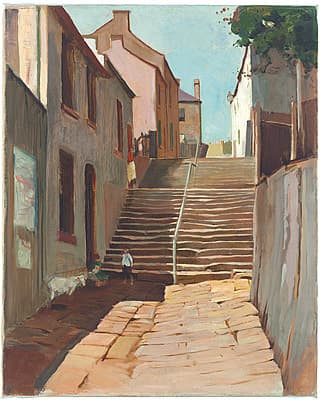Sydney
LONG
Australia
1871
–
London
1955
England, Europe 1910-21; Australia 1921- 22; England 1922-25; Australia 1925-52; England from 1952
48.0 (h) x 39.0 (w) cm Mitchell Library, State Library of New South Wales ... Mitchell Library, State Library of New South Wales, Sydney, transferred 1920
The bubonic plague erupted in Ferry Lane on 19 January 1900.
The sun beat down hard that Friday, casting a shimmering silver net over the waters of the harbour and baking Sydney’s unsealed streets until cart wheels and horses’ hooves raised clouds of choking dust. Through those crowded avenues rode Arthur Payne, a 30-year-old wagon driver, fair of skin and said to be of anxious disposition. With good reason, as it turned out. Arthur was seized by dizziness, nausea and a headache of unmatched ferocity that January morning. He struggled through his duties before dragging himself home to 10 Ferry Lane just before sunset. There, he dosed himself with some castor oil, vomited enormously and collapsed into bed, the first victim of bubonic plague in Sydney. Arthur survived his brush with history. More than 300 of his fellow Sydneysiders, many of them his neighbours, did not. (John Birmingham, SMH, 31 March 2011)
Paradoxically, Ferry Lane in the Rocks area of Sydney survived demolition following the plague.
Images of Ferry Lane by A.J. Daplyn and W.J. Thomas were also included in the Exhibition of pictures of old Sydney 1902. Lionel Lindsay later made two etchings of the street, one in 1918 and another in 1925. The 1918 etching is an almost identical view to Long’s painting. In this same year, Lindsay produced his softground etching, Pastoral (cat 114), which he based on one of Long’s watercolours, and which subsequently both artists co-signed. Lindsay may well have also based his Ferry Lane etching on Long’s work.
The bubonic plague erupted in Ferry Lane on 19 January 1900.
The sun beat down hard that Friday, casting a shimmering silver net over the waters of the harbour and baking Sydney’s unsealed streets until cart wheels and horses’ hooves raised clouds of choking dust. Through those crowded avenues rode Arthur Payne, a 30-year-old wagon driver, fair of skin and said to be of anxious disposition. With good reason, as it turned out. Arthur was seized by dizziness, nausea and a headache of unmatched ferocity that January morning. He struggled through his duties before dragging himself home to 10 Ferry Lane just before sunset. There, he dosed himself with some castor oil, vomited enormously and collapsed into bed, the first victim of bubonic plague in Sydney. Arthur survived his brush with history. More than 300 of his fellow Sydneysiders, many of them his neighbours, did not. (John Birmingham, SMH, 31 March 2011)
Paradoxically, Ferry Lane in the Rocks area of Sydney survived demolition following the plague.
Images of Ferry Lane by A.J. Daplyn and W.J. Thomas were also included in the Exhibition of pictures of old Sydney 1902. Lionel Lindsay later made two etchings of the street, one in 1918 and another in 1925. The 1918 etching is an almost identical view to Long’s painting. In this same year, Lindsay produced his softground etching, Pastoral (cat 114), which he based on one of Long’s watercolours, and which subsequently both artists co-signed. Lindsay may well have also based his Ferry Lane etching on Long’s work.
The bubonic plague erupted in Ferry Lane on 19 January 1900.
The sun beat down hard that Friday, casting a shimmering silver net over the waters of the harbour and baking Sydney’s unsealed streets until cart wheels and horses’ hooves raised clouds of choking dust. Through those crowded avenues rode Arthur Payne, a 30-year-old wagon driver, fair of skin and said to be of anxious disposition. With good reason, as it turned out. Arthur was seized by dizziness, nausea and a headache of unmatched ferocity that January morning. He struggled through his duties before dragging himself home to 10 Ferry Lane just before sunset. There, he dosed himself with some castor oil, vomited enormously and collapsed into bed, the first victim of bubonic plague in Sydney. Arthur survived his brush with history. More than 300 of his fellow Sydneysiders, many of them his neighbours, did not. (John Birmingham, SMH, 31 March 2011)
Paradoxically, Ferry Lane in the Rocks area of Sydney survived demolition following the plague.
Images of Ferry Lane by A.J. Daplyn and W.J. Thomas were also included in the Exhibition of pictures of old Sydney 1902. Lionel Lindsay later made two etchings of the street, one in 1918 and another in 1925. The 1918 etching is an almost identical view to Long’s painting. In this same year, Lindsay produced his softground etching, Pastoral (cat 114), which he based on one of Long’s watercolours, and which subsequently both artists co-signed. Lindsay may well have also based his Ferry Lane etching on Long’s work.

